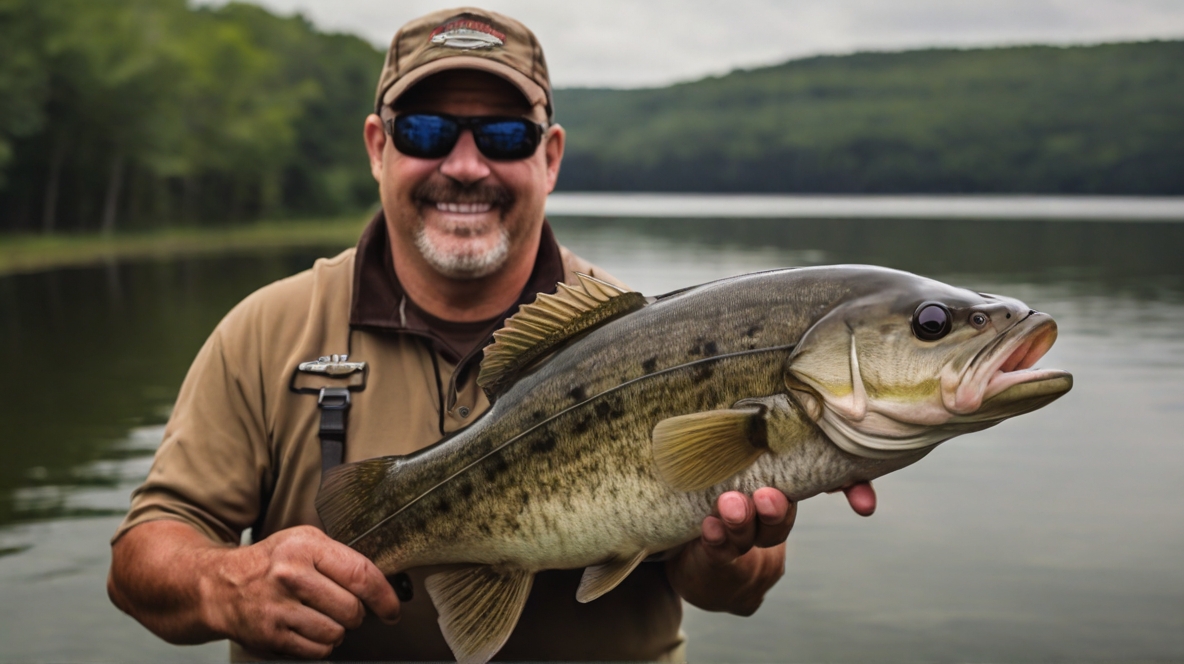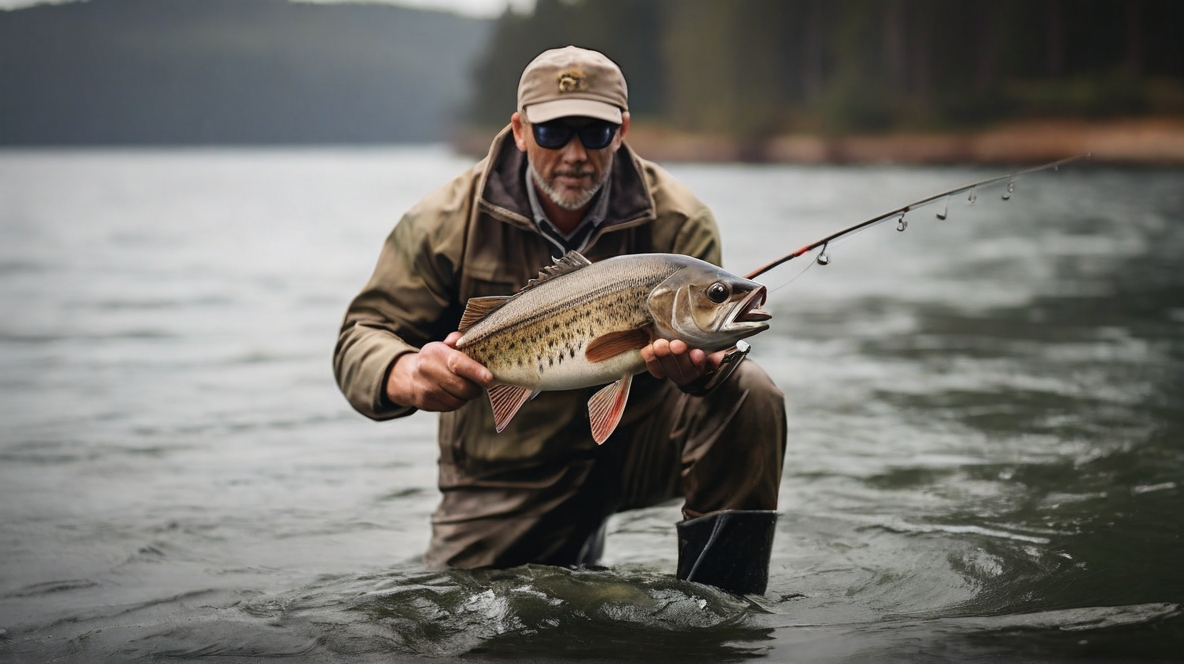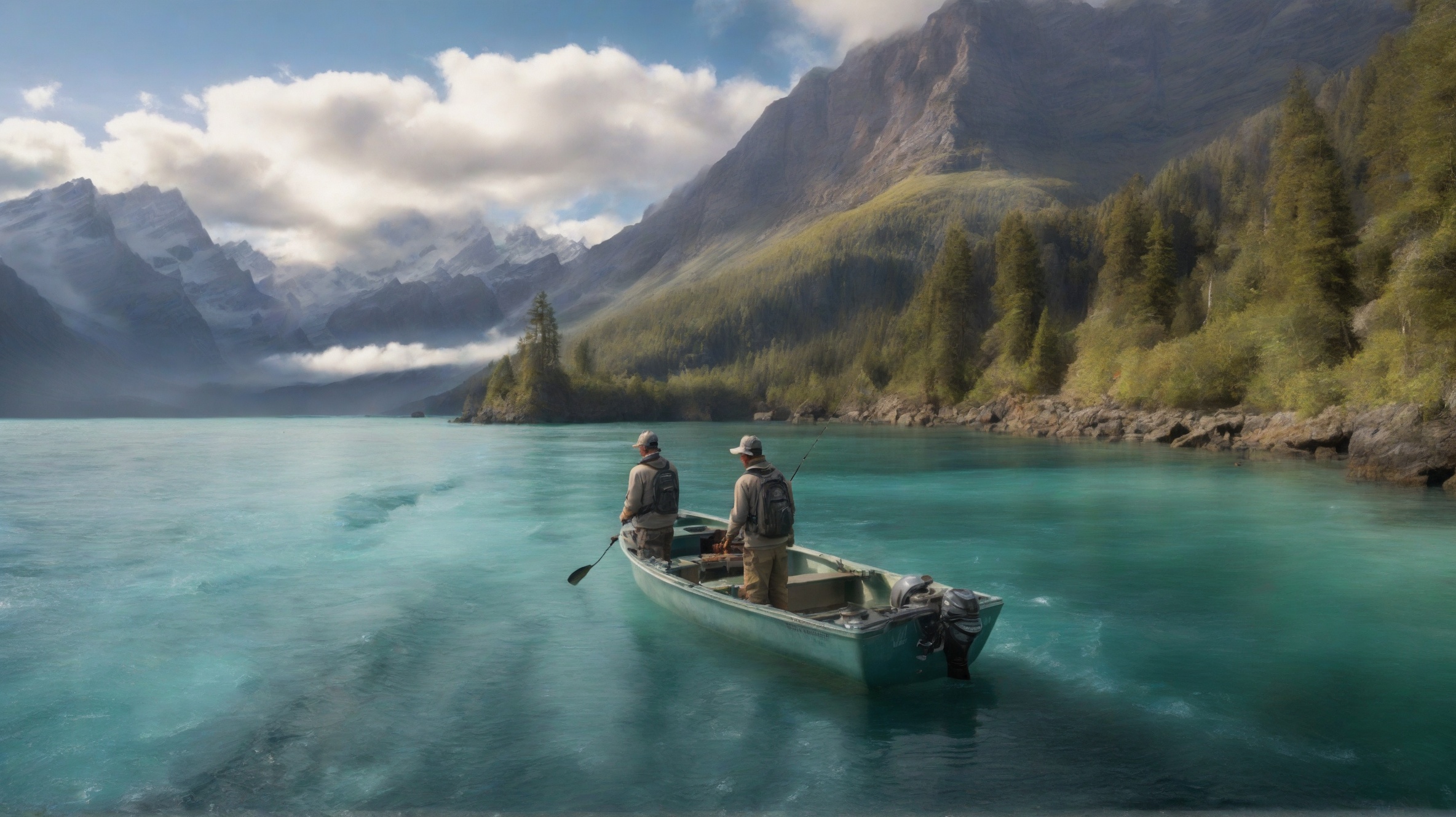Dive into the thrilling realm of bass fishing, an angling adventure that brings you face-to-face with the spirited largemouth and elusive smallmouth bass. This sport isn’t just about casting a line; it’s a passionate pursuit where each catch is a story, and every outing teaches a new lesson. “Bass Fishing Bonanza: Tips and Tricks for Pursuing Largemouth and Smallmouth” is your essential guide to understanding these captivating creatures and the strategies that bring success.
Largemouth bass, the robust warriors of freshwater, await in hidden depths, ready for a fierce battle. Smallmouth bass, their spirited cousins, thrive in cooler waters, offering a different but equally exhilarating challenge. This guide is your companion in decoding their world, helping you select the right lures, understand their habitats, and master the techniques that make or break the game.
Whether you’re a beginner with a budding interest or a seasoned angler aiming to refine your skills, you’ll find insights here that resonate with your love for the sport. It’s not just about the catch; it’s about respecting the water, the fish, and the fight. As you turn each page, prepare to enrich your understanding and deepen your appreciation for bass fishing. This isn’t just a pastime; it’s a way of life that honors tradition, patience, and the great outdoors. So gear up, set out, and let the “Bass Fishing Bonanza” guide you to your best catch yet. The water is calling, and adventure awaits.
Understanding Your Prey
- Embarking on your bass fishing journey begins with a fundamental step: knowing the quarry you seek. The largemouth and smallmouth bass, each with their distinct habits and habitats, are not just fish but formidable opponents in the angler’s quest. This section of “Bass Fishing Bonanza” is dedicated to unraveling the mysteries of these two celebrated gamefish, providing you with the insights needed to understand and respect your aquatic adversaries.Largemouth Bass: The Behemoth Beneath
- Largemouth bass, often simply referred to as ‘the bass,’ are the quintessential freshwater gamefish. These green-backed warriors can grow to impressive sizes, with some trophy catches weighing in over 10 pounds. They’re known for their aggressive strikes and dramatic fights, making them a favorite target for anglers seeking a thrilling catch.Largemouths prefer warmer waters and are commonly found lurking around structures like submerged logs, weed beds, and docks. These areas offer them shelter and a vantage point to ambush prey. Understanding this behavior is crucial. It’s about predicting their next move, knowing when a gentle twitch of your rod could turn a quiet moment into a heart-pounding battle. The largemouth bass isn’t just a fish; it’s a challenge that demands your respect and skill.Smallmouth Bass: The Fierce Fighter
- While they may share part of their name with their largemouth cousins, smallmouth bass offer a distinct and equally exhilarating fishing experience. Often found in cooler, clearer waters, these bronze-backed fish are celebrated for their spirited fight once hooked. Smaller than largemouths, what they lack in size, they more than make up for in tenacity.Smallmouth bass prefer rocky areas, river currents, and clear lakes. They’re a cunning adversary, often requiring a more finesse approach. Anglers targeting smallmouths speak of the subtle art of lure presentation and the thrill of seeing these fierce creatures leap from the water in a display of defiance. Pursuing smallmouth bass is not just fishing; it’s a dance between angler and fish, each step calculated and deliberate.Behavior and Patterns
- Both species of bass follow specific patterns that can predict their behavior. Temperature, time of year, and even the time of day can significantly influence their activity levels and feeding habits. For instance, largemouth bass might retreat to cooler, deeper waters during the hottest part of the day or during the height of summer. Conversely, smallmouth bass might become more active, using the increased water clarity and their superior vision to hunt.Understanding these patterns is like learning the language of the lake. It’s about more than just where to cast your line; it’s about knowing when to be there and how to present your lure. It’s this deep understanding that transforms an ordinary fishing trip into a true bass fishing bonanza.The Challenge and the Reward Fishing for bass is as much a mental challenge as a physical one. Each cast is a question asked, and each strike is an answer received. The thrill of the catch, the respect for the fish, and the continual learning and adaptation are what draw anglers back to the water time and time again.As you gear up for your next bass fishing adventure, remember that understanding your prey is the first step in a dance that can last a lifetime. It’s not just about the fish you catch; it’s about the stories you’ll tell and the memories you’ll create. So, study these magnificent creatures, respect their habits and habitats, and prepare for the thrilling pursuit of the largemouth and smallmouth bass.
Essential Gear for Bass Fishing
As you prepare to embark on your bass fishing adventure, equipping yourself with the right gear is akin to a knight arming for battle. Your success, enjoyment, and the very tale of the day will often hinge on the tools at your disposal. The world of fishing gear is vast and varied, but let’s focus on the essentials that every bass angler should have in their arsenal.
Rods: Your Fishing Lance
Choosing the right rod is like finding a trusty sword. For bass fishing, a medium-heavy rod offers the versatility needed for various lures and techniques. It should be long enough to cast far yet sensitive enough to feel the slightest nibble. A rod between 6.5 to 7.5 feet strikes a good balance for most situations. Remember, the rod is your primary link to the underwater world of the bass, so choose one that feels like an extension of your own arm.
Reels: The Trusty Steed
A good reel is your steadfast companion in the heat of the battle. For beginners, a spinning reel is often recommended due to its ease of use and versatility. However, as you grow in skill and confidence, a baitcasting reel offers more precision and control, especially when wrestling with a larger bass. Look for a reel with a smooth drag system and sufficient line capacity. This is your workhorse; it needs to be reliable.
Line: Your Unseen Ally
The fishing line is often overlooked, but it’s the silent hero in every catch. Monofilament lines are great for starters — they’re forgiving and affordable. However, when you’re ready to step up your game, fluorocarbon lines offer better sensitivity and invisibility underwater, making them a wise choice for wary bass. The weight of the line should match your target and conditions; for most bass fishing scenarios, something in the 6-12 pound test range is suitable.
Tackle: The Tools of the Trade
Your tackle box is your treasure chest, filled with the tools and trinkets that can lure and defeat the bass. At its heart should be a variety of lures: plastic worms for their versatility, crankbaits for their range, and spinnerbaits for their flash and vibration. Don’t forget the essentials like hooks (in various sizes), weights, and bobbers. Each item in your tackle box is a potential key to unlocking a successful day on the water.
The Ensemble: Putting It All Together
Just as a knight’s armor is a carefully considered ensemble, so too is your fishing gear. Each piece, from rod to lure, plays a critical role in your quest for the bass. They must work in harmony, suited to both your style and the conditions of the day. As you gather your gear, think of it not just as equipment, but as trusted allies in your ongoing adventure.
As you pack your gear and prepare to set out, remember that while the right equipment is crucial, it’s your skill, patience, and respect for the fish and the environment that truly make you a bass angler. The water awaits, your gear is ready — now go forth and fish!
Mastering Bass Fishing Techniques
Embarking on a bass fishing adventure is akin to entering a dance, where rhythm, technique, and understanding of your partner — in this case, the bass — are crucial. Mastering bass fishing techniques is not just about casting your line into the water; it’s about harmonizing your actions with the environment and the elusive creatures beneath the surface.
Casting with Precision and Purpose
Casting is the first step in your dance with the bass. It’s about more than just sending your lure into the water; it’s about placing it where the bass are hiding, be it near structures, drop-offs, or weed beds. Practice the art of casting until you can place your lure precisely where you want it, as quietly as possible, to avoid startling the fish. Whether you’re using a spinning or baitcasting reel, mastering the cast is a foundational skill that sets the stage for success.
Retrieval: The Art of Temptation
Once your lure hits the water, the real magic begins. Retrieving your lure is an art form that requires understanding how bass react to prey. Vary your speed, add occasional twitches, and pause to make your lure mimic the movements of real fish. The goal is to entice the bass, to make your lure the most irresistible thing in the water. Pay attention to the feedback through your line and rod; it tells a story of what’s happening below the surface.
Adapting to the Seasons
Bass behavior changes with the seasons, and so should your techniques. In warmer months, bass are more active and might respond well to faster retrieves and topwater lures. As the water cools, slow down your approach, use deeper diving lures, and focus on areas where bass might seek refuge from colder temperatures. Understanding these seasonal patterns and adapting your techniques accordingly will make you a more versatile and successful angler.
Mastering bass fishing techniques is a journey, one of continual learning and adaptation. Each outing is an opportunity to refine your skills, understand the bass a little better, and enjoy the dance between angler and fish. With patience, practice, and a deep respect for the sport, you’ll find yourself not just fishing, but performing a delicate ballet on the water, one that brings joy, excitement, and, hopefully, a bountiful catch.
Lure Selection Guide
Selecting the right lure is like choosing the perfect bait for a trap; it’s about understanding what your prey finds irresistible. In the diverse world of bass fishing, each lure has its story, its purpose, and its moment to shine. This guide will help you navigate through the myriad of options, ensuring you have the right lure for every situation.
Topwater Lures: Dancing on the Surface
Imagine the thrill of seeing a bass leap out of the water to snatch your lure. Topwater lures offer this exhilarating experience. They’re designed to mimic the movement of prey like frogs or injured fish on the water’s surface. Use these when the water is calm, usually early morning or late evening. The key is in the retrieval — a rhythm of pops and pauses that mimics life. Watch and listen for the splash; it’s a sign you’ve fooled a bass into striking.
Jigs and Soft Plastics: The Understated Charm
Jigs and soft plastics are the quiet achievers of the lure world. They might not have the flash of crankbaits or the drama of topwater lures, but they’re versatile and effective. Jigs, with their weighted heads and feathery skirts, are perfect for bouncing along the bottom, near structures where bass hide. Soft plastics can be rigged in various ways to suit different conditions. Their subtle movement can tempt even the wariest bass. Patience and a gentle touch are your friends here.
Crankbaits and Spinnerbaits: The Busy Bees
When you need to cover a lot of water and grab the attention of bass, crankbaits and spinnerbaits are your go-to options. Crankbaits dive down, wobbling and flashing to mimic a swimming fish. Their depth and movement are determined by their design and how fast you reel them in. Spinnerbaits, with their spinning blades, create vibration and light reflection, simulating the movement of small baitfish. They’re ideal for murky waters or when you’re not quite sure where the bass are hiding.
Each lure in your tackle box holds the potential for a successful catch. But remember, it’s not just about the lure; it’s about how you present it. Think like a bass, feel the water, and let your lure come to life. With the right selection and a bit of practice, you’ll be turning your fishing trips into bass-catching bonanzas in no time.
Reading the Water: Where to Find Bass
Unlocking the secrets of where bass lurk is akin to understanding a mysterious language spoken only by the waters. “Reading the water” is a term often whispered among seasoned anglers, a skill that separates novices from masters. It’s about interpreting the signs and whispers of the water to predict where the bass will be. Let’s dive into this art, guiding you to become more attuned to the aquatic world and better at pinpointing your next big catch.
Structural Insights: Decoding Bass Hideouts
Bass are creatures of habit and comfort, seeking out areas where food is plentiful and predators are scarce. They often congregate around structures – submerged logs, rock piles, weed beds, and docks. These areas provide shelter and an excellent vantage point for ambushing prey. As an angler, your first task is to scan the water for these structures. Look for irregularities along the shoreline, changes in water color indicating depth changes, or patches of vegetation. These are the signs that lead you to bass.
Temperature and Oxygen: Invisible Clues
Water temperature and oxygen levels play a crucial role in determining bass location. Bass prefer water that’s not too hot, not too cold, and rich in oxygen. In warmer months, they might retreat to cooler, deeper areas or places with moving water, as these tend to have higher oxygen levels. In cooler seasons, they’ll move to shallower areas where the sun has warmed the water. Learning to gauge these conditions isn’t just science; it’s an intuition developed over time and many fishing trips.
Seasonal Shifts: Following the Rhythms of Nature
As the seasons change, so does the behavior of bass. In spring, they move to shallower areas to spawn, making them easier to find. Summer sees them seeking comfort in deeper, cooler waters during the day and coming to the shallows to feed at dawn and dusk. Fall brings them back to the shallows as they aggressively feed to prepare for winter, while in winter, they slow down and retreat to deeper spots.
Reading the water isn’t just a skill; it’s a dialogue between you and the natural world. It’s about observing, understanding, and respecting the rhythms of the environment. As you spend more time with your line in the water, watching the world beneath the surface and the world around you, you’ll find yourself becoming more attuned to these subtle signs. And with each insight, you’ll find yourself one step closer to where the bass are waiting.
As we reel in our exploration of the bass fishing world, it’s clear that this sport is more than just casting a line; it’s an immersive experience that tests skill, patience, and respect for nature. Whether you’re drawn to the aggressive strikes of largemouth bass or the spirited fights of smallmouths, the journey is filled with learning and excitement at every turn. Remember, the most successful anglers aren’t just those with the fanciest gear or the longest casts; they’re the ones who read the water, understand the fish, and adapt with the ever-changing dance of nature.
As you pack your tackle box and plan your next trip, carry with you the tips and insights shared in this guide, but also embrace the personal growth and unique journey that bass fishing offers. Celebrate each catch, learn from every empty hook, and respect the incredible creatures that make this sport possible. The world beneath the water’s surface is a dynamic and beautiful place, and you’re now better equipped to enjoy all it has to offer. So, here’s to tight lines, big catches, and the continual joy of discovering what lies in the depths of bass fishing. Your adventure on the water awaits!









